This Christmas we have been showing you our version of the twelve days of Christmas through our collection.
We hope you have enjoyed seeing all the different objects (and Twinkle and Jubilee) so we thought we would tell you a bit more about each item. We have also had a go at singing the song (just the last verse!) – please click here to listen.
One Drummond Tartan Silk Dress
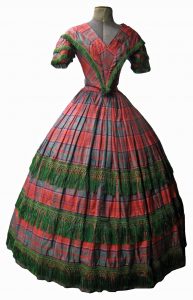
This Victorian silk dress dating from the 1840s was made for Lady Clementa Elizabeth Willoughby d’Eresby for the occasion of Queen Victoria’s visit to Drummond Castle in Perthshire. The dress was later altered, the sleeves removed and was worn at the Empire Ball in the Albert Hall, London by Lady Muriel Willoughby, granddaughter-in-law of Lady Clementa.
Two Shetland Ponies
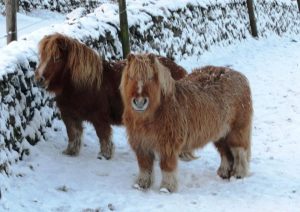
Twinkle and her son Jubilee are permanent members of the team here at the museum. The Shetland pony originates in the Shetland Isles, where ponies were first used for pulling carts, carrying peat, coal and other items, and ploughing farm land. Shetlands have long thick manes and tails and dense double winter coats to withstand harsh weather. They love to meet our visitors so make sure you say hello next time you are in!
Three Pretty Hats
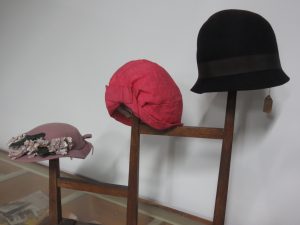
The costume collection includes much fashionable female costume from the early 19th century to the mid 20th century including fine examples of the use of tartan in 19th century Highland society. The collection includes dresses, petticoats, capes, caps and mutches, shawls and stoles. The three hats shown here date from the first half of the 20th century.
Four Barvas Pots
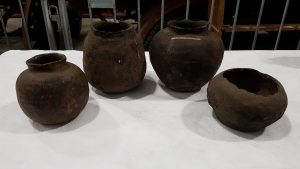
In the Hebrides a distinctive type of pottery survived in use until within the last hundred years and in some areas of Lewis within living memory. The Barvas Ware collection reflects both an old indigenous tradition of pottery making and a relatively modern, exotic tradition. The pots or ‘Craggans’ were used for food storage. One pot is inscribed ‘Craggan from the Isle of Lewis, for storing milk, 1886’.
Five pairs of Stockings
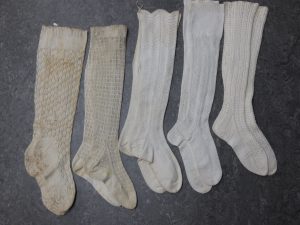
In the late 15th century knitted clothes began to be made and worn in Scotland. The earliest knitters were craftsmen who produced flat caps or bonnets. By the 17th century knitting became more widely known and it entered the female domain of domestic crafts. Making stockings became an important source of extra income in many parts of Scotland. These white stockings dating from the 19th century are believed to be part of burial clothing.
Six Quaichs

One of the most distinctive and enduring of drinking vessels produced by Highland craftsmen was the quaich. Early examples were carved from wood, but by the 17th century more elegant versions were being turned on lathes. They were also made from other materials including horn, silver and tin.
Seven spindles
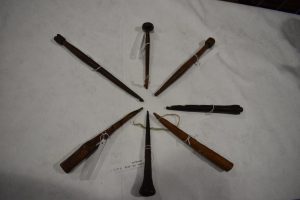
The oldest implement used for spinning is the spindle. Spindles come in many shapes and sizes – a straight rod weighted with a stone with a hole in the middle (whorl) or shaped so has to have a wider lower end. The process of using a spindle is very simple. The thread is twisted and lengthened by the dangling spindle which is weighted to spin when given a twirl by the finger and thumb.
Eight lamps
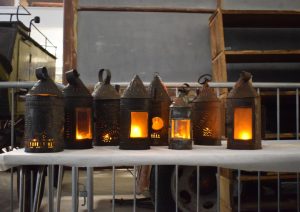
Pierced sheet pendant lanterns have been recorded from the 17th century. Some of our lanterns are pierced all over the body and roof. The light issuing from such a lantern is so scattered that the type were quite ineffectual either to light the bearer’s footsteps or to shed a good light in a barn, rather the object of these cheaply produced lanterns was as a safety light. Low door lintels, projecting beams and wall edges could be well marked at night by a hanging pierced lantern and when lit, myriad tiny firefly points of light would warn of the hazard.
Nine thatched houses
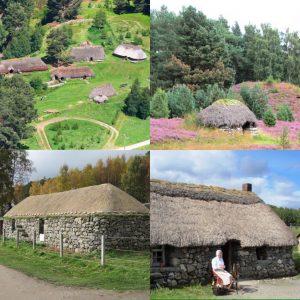
Our township recreation, interpreted for the 1730s, is founded on physical excavation, documentary research and practical experimentation. The eight structures that form the township are made from natural or organic materials including stones, timber and turf. The thatch is of locally collected vegetation such as heather, broom, bracken or reeds.
Ten ploughs
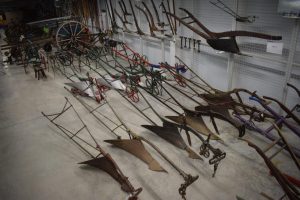
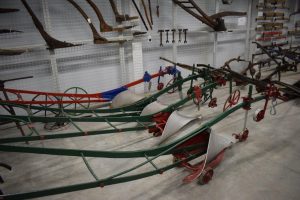
The collection of c 20 ploughs includes a wooden plough of James Small of Berwickshire’s influence and strongly reflects Scottish plough development and use to the mid-1900s. Several ploughs in the collection were made by individual blacksmiths. Competition ploughing was a highlight of the farming year and the collection includes three competition ploughs by Cameron of Tulliemet, Perthshire and a superb plough made by Laing of Advie, Moray.
Eleven Churns
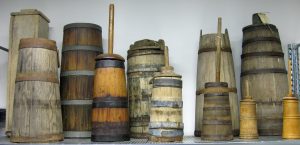
The objects relating to the dairy in the collection represent a significant overview of this once essential and near-universal process in a Highland context. The dairy collection is quite unique in both its comprehensiveness, and the time period that it covers. There is a large collection of churn types including staved plunge churns with two bound by hand-split willow.
Twelve horn spoons
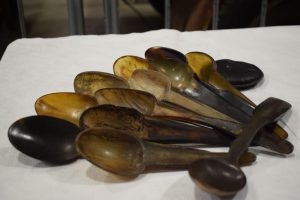
The making of horn spoons was a craft skill closely guarded by the Travellers. After being softened by heating, either by fire or boiling, the cow horn was pressed between two parts of a wooden mould to create a crudely shaped spoon. Horn spoons were indispensable in Highland homes and were widely used until the mid 19th century.
Happy New Year to you all!

